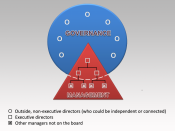McBride Financial Services � PAGE �1�
Running head: MCBRIDE FINANCIAL SERVICES GOVERNANCE EVALUATION
McBride Financial Services Governance Evaluation
University of Phoenix
�
McBride Financial Services Governance Evaluation
This paper evaluates the case of McBride Financial Services, Inc. (MFSI), evaluating the problems in corporate governance leading to the scandals in the early 21st century. Also the influence of the governance rating industry on American corporations, Governance rating schemes and methodologies and Corporate America's reaction to the governance rating industry are evaluated. According to Chew and Gillan (2004, p. 73), before the 1980s, the structure of corporate governance of large corporations allowed managers to think of the corporation rather than the shareholders. The "goal was not to maximize shareholder wealth, but to ensure the growth" of the company "by balancing the claims of all important corporate stakeholders, employees, suppliers, and local communities as well as shareholders." Since 1980, corporate governance has changed dramatically.
Corporate governance problems leading up to the corporate scandals of the early 21st century
Many problems occurred that led up the corporate scandals of the early 21st century, originating from the misstatement of financial reporting by the trusted executives of public companies. These misrepresentations included overstating revenues and assets, understating liabilities and expenses, using fictitious and fraudulent transactions, and direct falsification of financial statements, resulting in a misleading impression of the company's financial status. In the 1980s and 1990s, shareholders received little acknowledgment, without any voice, change was inevitable, resulting in a revolutionized transformation of corporate governance for many organizations during this period. In the 1980s, in reaction to shareholder neglect, restructuring activities and hostile takeovers began increasing. U.S. companies use of debt financing was so extensive it resulted in corporate leverage ratios to substantially increase. "The wedge between actual and potential corporate performance became increasingly apparent,"...


